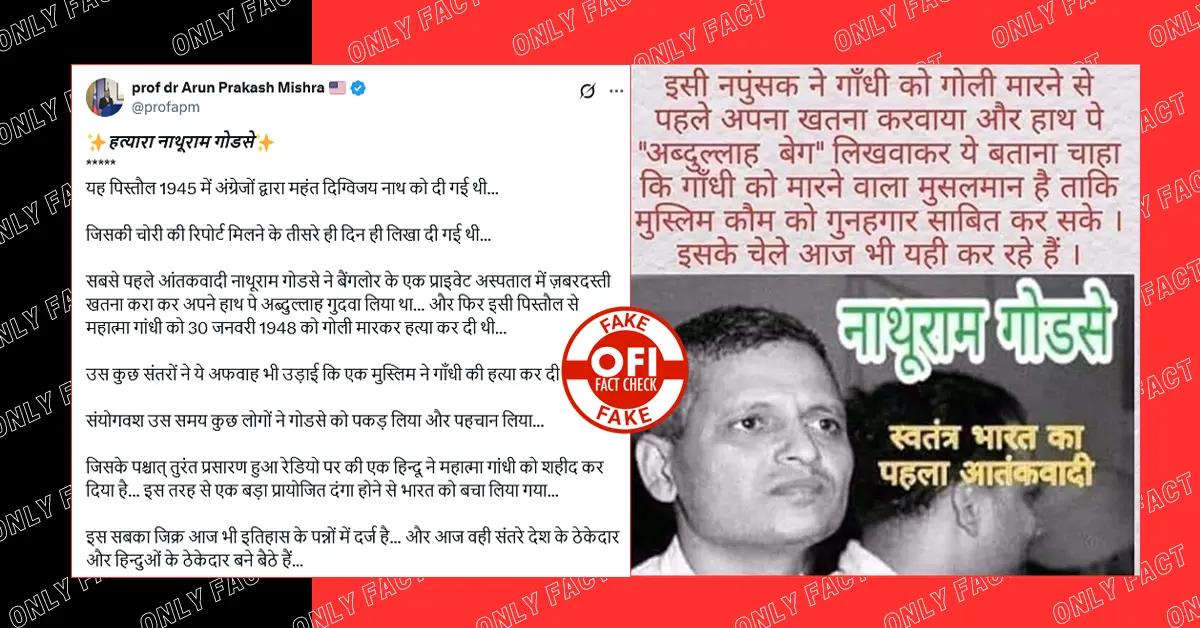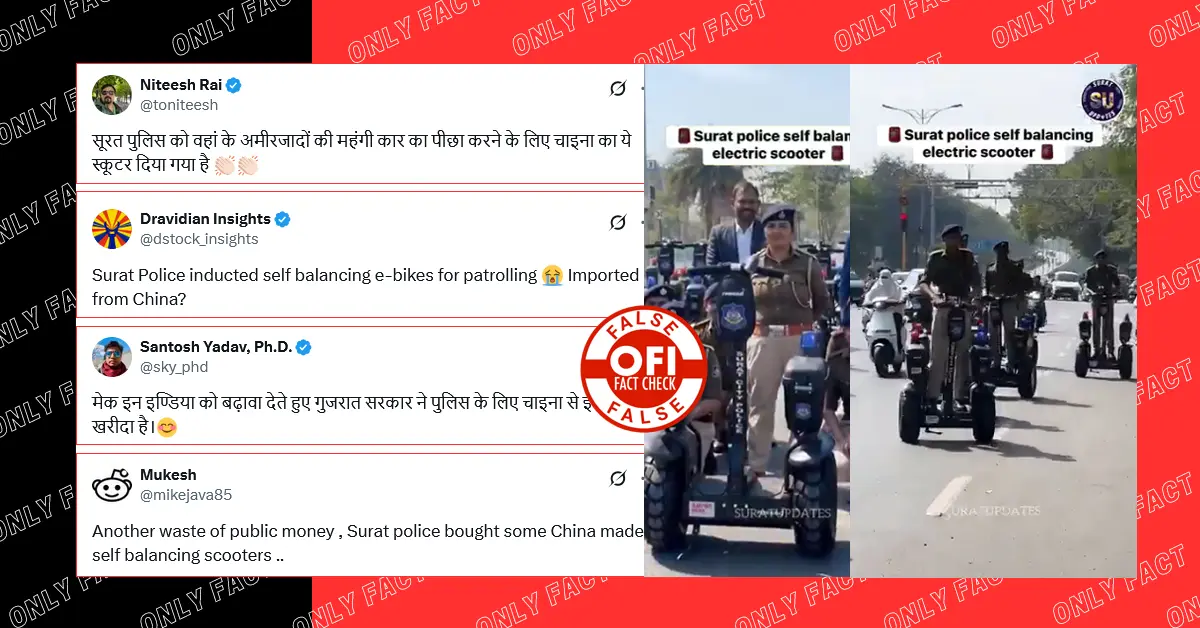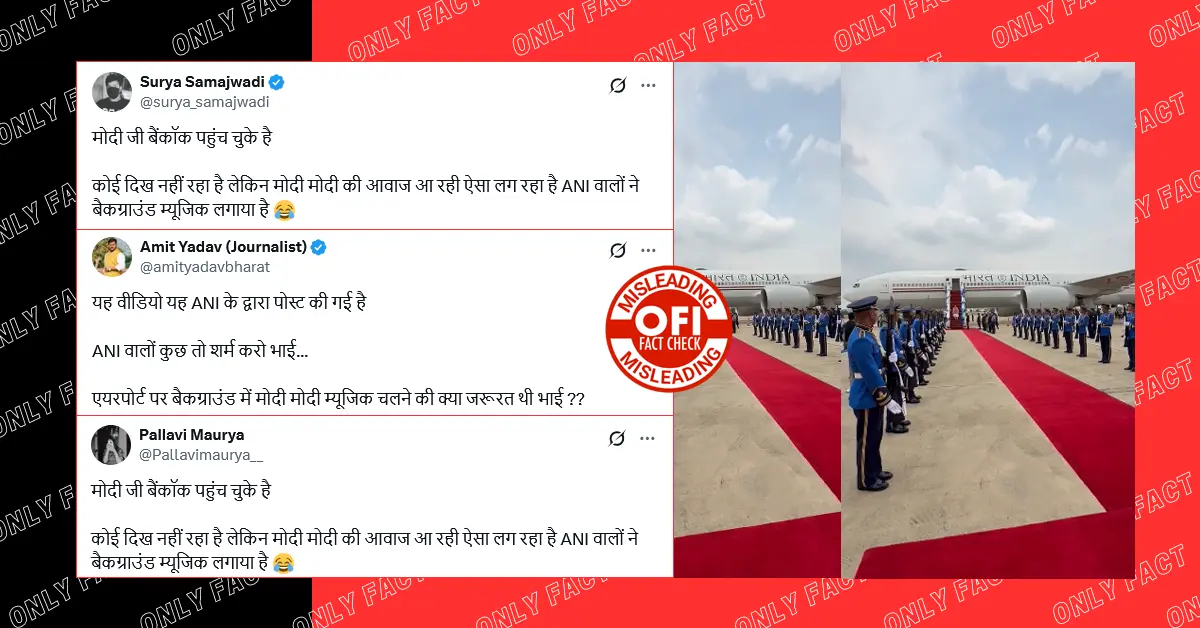A claim is being made on social media stating that before assassinating Mahatma Gandhi, Nathuram Godse forcibly underwent circumcision at a private hospital in Bangalore and got the name “Abdullah” tattooed on his hand. This claim suggests that due to these actions, a rumor spread at the time that a Muslim was responsible for Gandhi’s assassination.
While sharing this claim, Prof. Dr. Arun Prakash Mishra wrote, “This pistol was given to Mahant Digvijay Nath by the British in 1945, and a report of its theft was filed within three days of it going missing. The first terrorist, Nathuram Godse, forcibly underwent circumcision at a private hospital in Bangalore and got ‘Abdullah’ tattooed on his hand, then, using this very pistol, he shot and assassinated Mahatma Gandhi on January 30, 1948. Some individuals spread the rumor that a Muslim had killed Gandhi, but coincidentally, some people caught Godse at that time and identified him, following which a radio broadcast immediately announced that a Hindu had assassinated Mahatma Gandhi. In this way, India was saved from a major planned riot, and all of this is still recorded in the pages of history, yet today, those very people have become the self-proclaimed guardians of the nation and Hindus.” (Archived link)
✨️हत्यारा नाथूराम गोडसे✨️
— prof dr Arun Prakash Mishra 🇺🇲 (@profapm) March 31, 2025
*****
यह पिस्तौल 1945 में अंग्रेजों द्वारा महंत दिग्विजय नाथ को दी गई थी…
जिसकी चोरी की रिपोर्ट मिलने के तीसरे ही दिन ही लिखा दी गई थी…
सबसे पहले आंतकवादी नाथूराम गोडसे ने बैंगलोर के एक प्राइवेट अस्पताल में ज़बरदस्ती खतना करा कर अपने हाथ पे… pic.twitter.com/SVmXieMzcc
Also Read: Claim That Surat Police Imported Chinese E-Scooters Is False—They Are Made in India
Fact Check
In our fact-check research, we first conducted a keyword search related to this claim, but we did not find any media reports or historical documents mentioning that Godse underwent circumcision before assassinating Gandhi or got the name “Abdullah” tattooed on his hand.
In our further research, we found an article published by The Lallantop on November 8, 2020, titled “Why Did Godse Kill Gandhi?” The article discusses the reasons behind Godse’s assassination of Mahatma Gandhi and details his 90-page court testimony, where he justified his actions. This article references Manuben Gandhi’s book Last Glimpses of Gandhi and a New York Times report from January 31, 1948, both of which provide firsthand accounts of Mahatma Gandhi’s assassination.
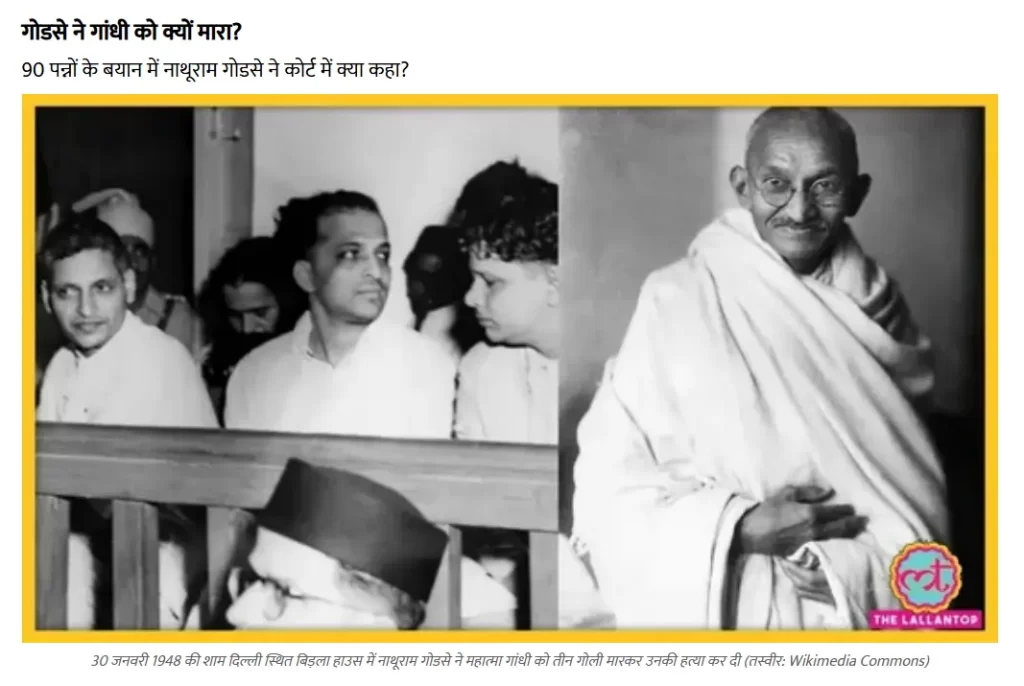
According to the article, on the evening of January 30, 1948, the prayer time at Birla Bhawan, Delhi, was set for 5 PM as usual. That day, Sardar Patel visited Gandhi, and while conversing with him, Gandhi lost track of time and was 10 minutes late for the prayer meeting. He arrived at 5:15 PM, holding the hands of his nieces. As soon as he reached, the crowd excitedly said, “Bapu has arrived.”
Manuben wrote in her book that when Gandhi arrived for the prayer, a man wearing a khaki bush jacket and blue pants approached and started touching his feet. Manuben told the man that Gandhi was already 10 minutes late. This man was Nathuram Godse. Godse pushed Manuben’s hand aside, causing her luggage to fall to the ground. As soon as she bent down to pick them up, she heard gunfire. When she turned around, she saw Gandhi lying down. There was no doctor present at the scene. Gandhi was taken inside, but due to excessive blood loss, he passed away instantly. Outside, Nathuram was shouting police-police with his hands raised.
Whereas, the New York Times report tells a different story. According to this report, an American named Herbert Reiner caught Godse and snatched his pistol. Some people present at the scene later stated that Godse did not try to run away and instead surrendered himself.
This article further mentions the meeting between Devdas Gandhi, son of Mahatma Gandhi, and Nathuram Godse in jail, taken from the book “Gandhi Hatya Ani Me” (translated as “Gandhi Murder and After”) by Gopal Godse, the brother of Nathuram Godse.
After Gandhi’s assassination, Devdas Gandhi went to meet Nathuram Godse in jail. Before the meeting, Devdas assumed that the assassin must have been a madman who shot Gandhi impulsively. However, when he met Godse, the latter reminded him that they had previously met at a press conference. During their conversation, Devdas asked Godse why he killed Gandhi. Godse admitted to the assassination and responded that it was not due to any personal reasons but rather a political motive. He also expressed regret for Devdas’s loss and said if he is given thirty minutes, he will narrate his motive behind the assassination. Godse was not given time that day.
However, before his death, he explained the reasons behind his actions in a six-hour-long statement. This was a 93-page statement, which was read in court on November 8, 1949.
Nathuram Godse, in his argument, stated that Gandhi was on a hunger strike demanding an end to riots in India and that India should give Pakistan its share of 50 crores. Godse believed that as long as Gandhi was alive, he would continue to act against India’s and Hindus’ interests. He further said that when Gandhi observed a fast in favor of Muslims, he realized that Gandhi’s existence needed to be ended. While Gandhi did great work for Indian rights in South Africa, Godse claimed his mentality changed after coming to India, where he saw himself as the ultimate judge of right and wrong.
Further, the BBC report also mentions Nathuram Godse’s 93-page statement, which he personally read in court. The article also notes that on November 9, 1948, during the courtroom proceedings, Judge Atma Charan posed 28 questions to Godse. In response to one of these questions, Godse admitted to shooting Gandhi. After the shooting, someone struck Godse on the head from behind, causing him to bleed. Godse told this man that his actions were premeditated and that he had no regrets.
In further research, we found the First Information Report (FIR) of Mahatma Gandhi’s assassination, dated January 30, 1948, at Birla House, New Delhi. The statement was given by Nand Lal Mehta, an eyewitness, who described that Gandhi was walking towards his prayer meeting around 5:10 PM, accompanied by Aba Ben Gandhi, Nand Ben Gandhi, and two other women. The crowd stood on both sides, leaving a passage in the middle for Gandhi.
As Gandhi moved forward to greet people, a man named Nathuram Vinayak Godse from Poona stepped out from the crowd and fired three shots at him from a distance of three feet. The bullets hit Gandhi’s stomach and chest, and he collapsed, uttering “Hey Ram.” Godse was immediately captured along with his pistol, and Gandhi was taken inside Birla Bhawan, where he passed away instantly. The police took the accused to Amarnath Police Station, where his crime was registered under Section 302 of the IPC.
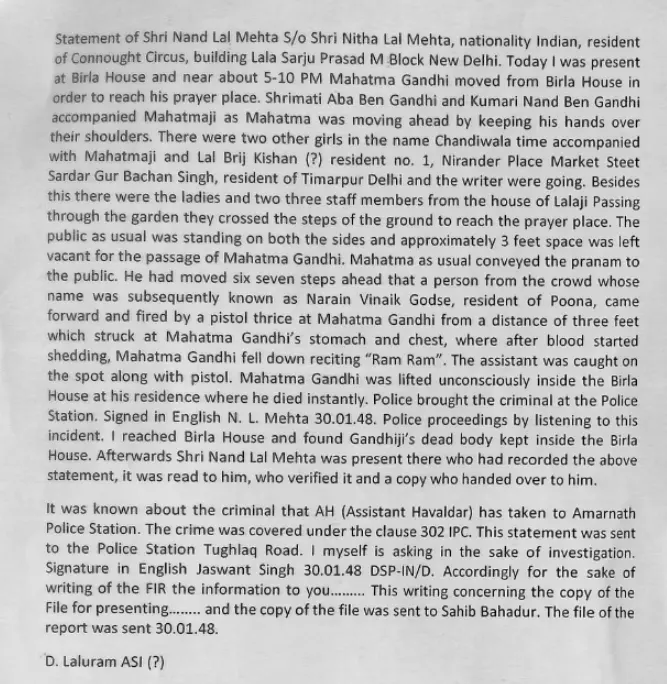
Further, we found a 205-page judgment report. This judgment report provides a comprehensive account of the assassination, the events leading up to it, the individuals involved, the legal proceedings, and the final verdict.
Chapter 11, ‘Incidents, Investigation, and Establishment of the Court,’ mentions that on 30.1.1948, at 5 PM, Mahatma Gandhi was putting up at Birla House, New Delhi. He was on his way to offer his usual evening prayer, accompanied by several people. As Mahatma Gandhi was climbing the stairs to the prayer platform, a man suddenly emerged from the crowd, came in front of him, and fired three shots at point-blank range in quick succession using a pistol. The man was immediately caught, and he was identified as Nathuram Godse, the prime accused in the case. Mahatma Gandhi was taken inside Birla Bhawan, where he succumbed to his injuries. The FIR in this case was lodged by Nand Lal Mehta, who was present at the prayer platform during the assassination.
This entire conspiracy, orchestrated by Nathuram Godse and his associates, dates back to the partition of India and Pakistan. In Chapter 3 of the judgment, titled “Prosecution Version of the Story,” it is mentioned that the partition of the country into two dominions was strongly resented by the accused, or at least by some of them. They believed that if Gandhi had not been there, the partition of the country would not have happened.
After the partition, minorities in Pakistan faced severe atrocities. In response to this, Mahatma Gandhi did everything he could to prevent any counterattacks on the minority communities within the Indian dominion. This action of Gandhi was also strongly resented by the accused, or at least by some of them. It was in the midst of Gandhi’s efforts to safeguard the minority communities in India that the accused entered into a conspiracy and hatched a plot to end his life.
Chapter 5, “Defense Version of the Story,” mentions that Nathuram Godse’s case argues that there was no conspiracy between him and the other accused to assassinate Mahatma Gandhi. It claims that his actions were his own individual decision. His motive for the murder, as stated in his written statement, was the partition of India into two dominions, for which he held Gandhi responsible. Another reason he gave was Gandhi’s fast on January 13, 1948, which, according to Godse, was meant to pressure the Government of India into paying ₹55 crore to Pakistan.
Nathuram Godse was charged under Section 120B of the IPC (criminal conspiracy), along with Section 302 IPC (murder). The judgment states that between December 1, 1947, and January 30, 1948, at Poona, Bombay, Delhi, and other locations, the accused had conspired to assassinate Mahatma Gandhi.
The final verdict in the Mahatma Gandhi assassination case found Nathuram Godse guilty under multiple charges of the IPC, the Indian Arms Act, and the Explosive Substances Act. He was convicted of criminal conspiracy, murder, illegal possession of arms, and various offenses under the Explosive Substances Act. His sentencing included multiple terms of rigorous imprisonment—two years each under two sections of the Arms Act, three years under one section of the Explosive Substances Act, five years under another, and seven years under yet another provision. However, his ultimate punishment was the death sentence under Section 302 IPC, where he was ordered to be hanged by the neck until death.
Nowhere in this judgment or FIR is it mentioned that Nathuram Godse got circumcised at a private hospital before assassinating Gandhi or that he got a tattoo of the name “Abdullah” on his hand.
A document on press reactions to the judgment in the Mahatma Gandhi murder trial reveals varying perspectives. The English press described the judgment as fair and impartial, while National Herald called it a “fit punishment for a dastardly crime” while also criticizing police negligence, stating that “the crime could have been averted if the police had been sufficiently alert.” The Bombay Sentinel pointed that “Gandhiji was against taking away the life of anyone, whatever the crime was. It would be well to commute the sentence to one of transportation for life.” Times of India described the trial as fair, whereas Patrika questioned police negligence and emphasized that they should be made conscious of their duties.
We examined this document and reviewed press reactions from multiple media sources, but none mentioned Godse undergoing circumcision or getting the name “Abdullah” tattooed on his hand.
| Claim | Nathuram Godse forcibly underwent circumcision at a private hospital in Bangalore and got the name “Abdullah” tattooed on his hand. |
| Claimed by | Social media user |
| Fact Check | No historical document or media report confirms this claim, indicating that it is false. Nathuram Godse’s motive for assassinating Gandhi was political. He held Gandhi responsible for the partition of the country and believed that Gandhi’s actions were against the interests of India and Hindus. |
Also Read: Old Bombay HC Ruling on Sexual Assault Goes Viral as Recent

